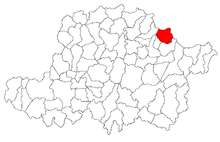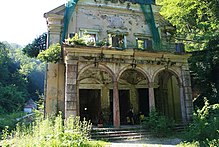Moneasa
|
Moneasa Moniasa Menyháza |
||||
|
||||
| Basic data | ||||
|---|---|---|---|---|
| State : |
|
|||
| Historical region : | Screeching area | |||
| Circle : | Arad | |||
| Coordinates : | 46 ° 27 ' N , 22 ° 15' E | |||
| Time zone : | EET ( UTC +2) | |||
| Height : | 290 m | |||
| Area : | 68.24 km² | |||
| Residents : | 864 (2011) | |||
| Population density : | 13 inhabitants per km² | |||
| Postal code : | 317220 | |||
| Telephone code : | (+40) 02 57 | |||
| License plate : | AR | |||
| Structure and administration (as of 2016) | ||||
| Community type : | local community | |||
| Structure : | Moneasa | |||
| Mayor : | Ioan Nuțu Herbei ( PSD ) | |||
| Website : | ||||
Moneasa (German: Moniasa , Hungarian: Menyháza ) is a municipality in the Arad district , in the Kreischgebiet , in western Romania .
Geographical location
Moneasa is located in the extreme northeast of Arad County on the border with Bihor County . The village is located in the Apuseni Mountains at the foot of the Codru-Moma Mountains , 102 km from Arad and 20 km from Sebiș . Moneasa is crossed by the river of the same name.
Neighboring places
| Bărzeşti | Apuseni Mountains | Apuseni Mountains |
| Suzani |

|
Apuseni Mountains |
| Slatina de Criș | Rănușa | Apuseni Mountains |
history
The first written mention of the village comes from the year 1597, when Sigismund Báthory mentioned the thermal springs and the iron ore deposits of Monyásza . Over the centuries different spellings of the place name appeared: 1619 Moneassa , 1774 Monyasza , 1828 and 1851 Monyaza or Monyasza and 1913 Menyház .
After the Treaty of Karlowitz (1699) Arad and the Maroscher Land came under Austrian rule , while the Banat south of the Marosch remained under Turkish rule until the Peace of Passarowitz (1718) . According to General Starhemberg's plans , the first garrisons of the Tisza-Marosher military border were set up in August 1699 and June 1701 , to which Moneasa belonged.
In 1804 Moneasa was owned by the Névery family, in 1847 it was sold to Count Waldstein Wartemberg Cristian (1794–1858), in 1891 it came into the possession of the widow of Count Friedrich Wenckheim. As a result of the Austro-Hungarian Compromise (1867), the Arad region was annexed to the Kingdom of Hungary within the Austro-Hungarian dual monarchy . The official place name was Menyháza .
The Treaty of Trianon on June 4, 1920 resulted in border regulation, whereby Moneasa fell to the Kingdom of Romania . The land reform of 1921 resulted in the expropriation of Countess Wenckheim's property. The land was given to unclaimed Romanian farmers through parceling.
The spa of Moneasa has been documented for its medicinal springs since 1597 . The buildings of today's thermal bath date from the year 1881. The water has a temperature of 25–32 ° C and is suitable for the treatment of diseases of the nervous system and the musculoskeletal system. In the marble quarry from Moneasa black and red marble is extracted. To the east of Moneasa was the Jumelt furnace in the 19th century , where iron ore from the Moneasa mines was processed.
Population development
| census | Ethnicity | |||||||
|---|---|---|---|---|---|---|---|---|
| year | Residents | Romanians | Hungary | German | Other | |||
| 1880 | 1044 | 883 | 100 | 16 | 45 | |||
| 1910 | 1290 | 1106 | 174 | 9 | 1 | |||
| 1930 | 1221 | 1119 | 81 | 2 | 19th | |||
| 1977 | 1183 | 1154 | 20th | 6th | 3 | |||
| 1992 | 1291 | 1253 | 24 | 7th | 7th | |||
| 2002 | 1056 | 1032 | 18th | 2 | 4th | |||
Web links
- ghidulprimariilor.ro , The municipality of Moneasa
- virtualarad.net , Moneasa
- eutopiamall.com , monograph: Moneasa
Individual evidence
- ↑ citypopulation.de , census October 20, 2011
- ↑ Mayoral elections 2016 in Romania ( MS Excel ; 256 kB)
- ↑ a b c d eutopiamall.com , Moneasa - monograph
- ↑ virtualarad.net , Moneasa
- ↑ kia.hu , E. Varga: Statistics of the population by ethnic group in the Arad district according to censuses from 1880 - 2002





